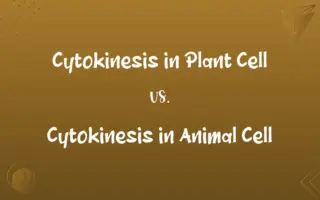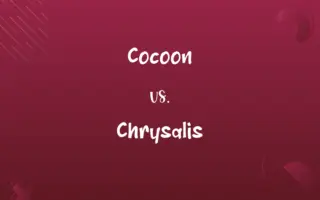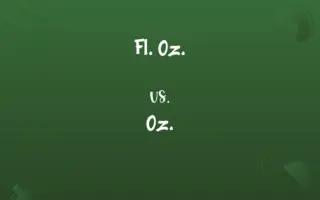Monocot Leaves vs. Dicot Leaves: Know the Difference

By Shumaila Saeed || Published on January 31, 2024
Monocot leaves have parallel veins and long, slender shapes; dicot leaves feature branched veins and a wide variety of shapes.

Key Differences
Monocot leaves are characterized by their parallel venation pattern, where veins run side by side without intersecting. Dicot leaves, in contrast, display a reticulate or branched venation pattern, with a main vein from which smaller veins branch out.
Shumaila Saeed
Jan 31, 2024
The shape of monocot leaves is generally long and slender, adapted for efficient water and nutrient transport. Dicot leaves tend to have a broader range of shapes, including oval, round, or even heart-shaped forms, reflecting their diverse ecological adaptations.
Shumaila Saeed
Jan 31, 2024
In monocot leaves, the stomata, which are pores for gas exchange, are typically uniformly distributed on both surfaces. Dicot leaves usually have a higher concentration of stomata on their lower surface, aiding in reduced water loss.
Shumaila Saeed
Jan 31, 2024
Monocot leaves often lack a distinct petiole (the leaf stalk) and are directly attached to the plant stem. Dicot leaves usually have a well-defined petiole, which helps orient the leaf blade for optimal light absorption.
Shumaila Saeed
Jan 31, 2024
The internal structure of monocot leaves shows less differentiation between the upper and lower sides, often leading to a more uniform texture. Dicot leaves have a more complex internal structure, with distinct upper and lower layers, contributing to varied textures and thicknesses.
Shumaila Saeed
Jan 31, 2024
ADVERTISEMENT
Comparison Chart
Leaf Shape
Generally long and slender.
Wide variety of shapes (oval, round, heart-shaped).
Shumaila Saeed
Jan 31, 2024
Stomata Distribution
Uniformly distributed on both surfaces.
Concentrated on the lower surface.
Shumaila Saeed
Jan 31, 2024
Petiole Presence
Often lack a distinct petiole.
Usually have a distinct petiole.
Shumaila Saeed
Jan 31, 2024
Internal Structure
Less differentiation between upper and lower sides.
Distinct upper and lower layers with varied textures.
Shumaila Saeed
Jan 31, 2024
ADVERTISEMENT
Monocot Leaves and Dicot Leaves Definitions
Monocot Leaves
Monocot leaves have a uniform distribution of stomata.
The lily's monocot leaves exhibit equal stomata distribution on both surfaces.
Shumaila Saeed
Jan 11, 2024
Dicot Leaves
Dicot leaves often have more stomata on the lower surface.
The concentration of stomata on the underside of oak leaves is a characteristic of dicots.
Shumaila Saeed
Jan 11, 2024
Monocot Leaves
Monocot leaves are typically long and narrow.
The long, narrow leaves of the corn plant are characteristic of monocots.
Shumaila Saeed
Jan 11, 2024
Dicot Leaves
Dicot leaves usually have a well-defined petiole.
The rose's leaves are attached to the stem by distinct petioles, typical of dicot plants.
Shumaila Saeed
Jan 11, 2024
Monocot Leaves
Monocot leaves often lack a distinct petiole.
The direct attachment of the palm leaf to the stem is due to its lack of a petiole, a monocot feature.
Shumaila Saeed
Jan 11, 2024
ADVERTISEMENT
Dicot Leaves
Dicot leaves feature branched venation.
The maple leaf's intricate branched venation is a hallmark of dicots.
Shumaila Saeed
Jan 11, 2024
Monocot Leaves
Monocot leaves have parallel venation.
The grass in the field displayed the typical parallel venation of monocot leaves.
Shumaila Saeed
Jan 11, 2024
Dicot Leaves
Dicot leaves have a wide variety of shapes.
The heart-shaped leaves of the violet are an example of the diverse shapes found in dicots.
Shumaila Saeed
Jan 11, 2024
Monocot Leaves
Monocot leaves usually have a simple structure.
The simplicity of bamboo leaves is a typical trait of monocot vegetation.
Shumaila Saeed
Jan 11, 2024
Dicot Leaves
Dicot leaves have a complex internal structure.
The thick, textured leaves of the hibiscus showcase the complex structure of dicot leaves.
Shumaila Saeed
Jan 11, 2024
Repeatedly Asked Queries
What defines a monocot leaf?
Monocot leaves are defined by their parallel venation and often slender shape.
Shumaila Saeed
Jan 31, 2024
How are dicot leaves different in shape?
Dicot leaves come in a variety of shapes, from oval to heart-shaped.
Shumaila Saeed
Jan 31, 2024
Can you find monocot leaves on trees?
Monocot leaves are mostly found on grasses and some shrubs, rarely on trees.
Shumaila Saeed
Jan 31, 2024
Is it easy to identify monocot leaves?
Yes, their parallel venation and shape make them easily identifiable.
Shumaila Saeed
Jan 31, 2024
Are dicot leaves better adapted to dry climates?
Their stomata distribution and structure can make them more adaptable to varied climates.
Shumaila Saeed
Jan 31, 2024
Do dicot leaves have a specific venation pattern?
Yes, dicot leaves typically have branched or reticulate venation.
Shumaila Saeed
Jan 31, 2024
Are monocot leaves efficient in photosynthesis?
Yes, their structure and venation pattern make them efficient in photosynthesis.
Shumaila Saeed
Jan 31, 2024
Are all grasses monocots?
Yes, grasses are typical examples of monocotyledons.
Shumaila Saeed
Jan 31, 2024
How does the petiole affect dicot leaf function?
It allows for better positioning and flexibility in response to environmental factors.
Shumaila Saeed
Jan 31, 2024
Are monocot leaves generally smaller than dicot leaves?
Not necessarily; size varies widely among different species.
Shumaila Saeed
Jan 31, 2024
Is water conservation different in monocot leaves?
Their uniform stomata distribution aids in efficient water use.
Shumaila Saeed
Jan 31, 2024
Are monocot leaves more common in certain habitats?
They're prevalent in grasslands and certain tropical regions.
Shumaila Saeed
Jan 31, 2024
Why do dicot leaves often have a petiole?
The petiole helps orient the leaf for optimal sunlight absorption.
Shumaila Saeed
Jan 31, 2024
Do monocot leaves have secondary growth?
No, monocots generally do not exhibit secondary growth.
Shumaila Saeed
Jan 31, 2024
Can dicot leaves change color in autumn?
Yes, many dicot leaves change color in autumn due to pigment changes.
Shumaila Saeed
Jan 31, 2024
Do all dicot leaves have visible veins?
Most do, but vein visibility can vary depending on the species.
Shumaila Saeed
Jan 31, 2024
Do dicot leaves have a more complex internal structure?
Yes, they often have a more complex structure with distinct upper and lower layers.
Shumaila Saeed
Jan 31, 2024
Can monocot leaves be found in aquatic plants?
Yes, many aquatic plants have monocot leaves.
Shumaila Saeed
Jan 31, 2024
Do dicot leaves have a role in seasonal changes?
Yes, their color changes contribute to seasonal foliage displays.
Shumaila Saeed
Jan 31, 2024
How does leaf structure affect dicot plant survival?
Their structure can influence light absorption, water retention, and gas exchange, affecting survival.
Shumaila Saeed
Jan 31, 2024
Share this page
Link for your blog / website
HTML
Link to share via messenger
About Author
Written by
Shumaila SaeedShumaila Saeed, an expert content creator with 6 years of experience, specializes in distilling complex topics into easily digestible comparisons, shining a light on the nuances that both inform and educate readers with clarity and accuracy.































































